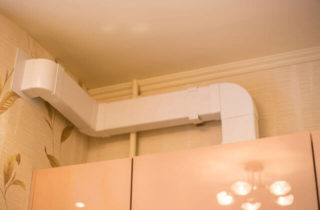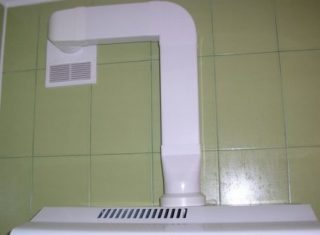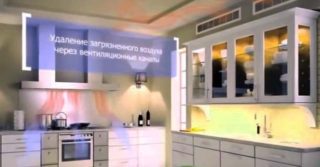The ventilation consists of ducts with a set of fasteners through which the exhaust air circulates. The exhaust pipe in the kitchen is connected to the dome, where fat, boiling vapors, carbon dioxide are drawn in. The design traps combustion products, prevents them from spreading to other premises of the house and accumulating in the form of soot on the walls and ceiling.
- The importance of the exhaust pipe in the kitchen and its application
- Advantages and disadvantages
- Difference from ventilation
- The main types of air ducts and their characteristics
- Plastic
- Corrugated aluminum
- Metal
- According to the degree of flexibility for the hood
- Selection Tips
- Dimensions and cross-section
- Diameter and shape
- Installation of a pipe for an exhaust hood in the kitchen
- Pipe outlet options
- With one entrance
- With two entrances
- Outside
The importance of the exhaust pipe in the kitchen and its application

The pipeline is installed as part of a flow-through or circulation ventilation system. The kitchen uses the first scheme, which completely removes dirty streams and does not reuse them after partial processing. For high-quality air purification, only the holes in the duct riser are not enough, therefore, ventilation pipes for gas hoods are used.
Advantages and disadvantages
The advantages include the fact that the pipe connects the domed hood to the entrance of the ventilation shaft and unpleasant odors in the air do not go to other rooms of the apartment. The manifold walls are made of strong and durable material that resists high temperatures and chemicals.
The disadvantage is the bulkiness and the need for embedding with decorative panels so as not to spoil the interior. Poor installation leads to increased fan noise. Pipelines require external and internal cleaning.
Difference from ventilation
The kitchen hood differs from natural ventilation in that it removes polluted air forcibly and does not depend on atmospheric and weather conditions. The pipe under the hood to the kitchen is not like general ventilation in that the structure removes the waste masses from a separate place, and does not provide general air exchange in all rooms.
The hood is not allowed to be installed in the kitchen if there is a gas water heater or a boiler with an open firebox in this room. Operation of the hood can lead to overturning of the draft in the chimney, if it is not provided with a forced draft.
The main types of air ducts and their characteristics
The regularity of cleaning the pipeline and its appearance depend on the material of manufacture. Aggressive substances in the composition of the air regularly act on the inner surface of the channel, which destroy the walls. The high temperature of the exhaust gases, steam and condensate also has a negative effect.
Plastic

PVC air duct is a rigid pipe with a round or rectangular cross-section. The dimensions of the plastic pipe for the kitchen hood are determined by the calculation method according to the formulas, depending on the number of burners, the distance to the shaft.
Positive aspects of using plastic pipes:
- smooth surface inside and outside facilitates cleaning of soot and grease deposits;
- when the turbine is operating, vibration noise is extinguished;
- can be combined with most finishing materials;
- robust elements resist condensation and hot steam.
The disadvantages include the need to purchase additional adapters and rotary elements.
On sale there are pipes made of polyvinyl chloride, polyurethane, polyethylene.
Corrugated aluminum

This type of pipe is made from a semi-rigid aluminum sheet, which is compressed in the form of an accordion. The manifold can be stretched to the required size due to this wall structure.
Advantages of aluminum corrugation:
- elements are easy to install, no connectors and adapters are used, because the pipe bends at an angle, the boxes are connected with clamps, cut with scissors;
- easily disassembled and reassembled;
- soft bends of the pipeline do not create an additional obstacle to the air flow;
- do not burn or melt.
The disadvantage of a corrugated pipe is the presence of folds on the inner surface, in which soot and fat are collected. Once stretched, the element cannot be returned to its original length. The pipeline is less aesthetically pleasing than PVC.
Metal

Before the advent of plastic collectors, pipes for kitchen hoods were made of galvanized or stainless steel. Products are still used today, but they are placed in industrial premises or public institutions. The boxes are lightweight, durable and resistant to thermal effects. Sometimes the outside is powder coated.
The thickness of the collector walls depends on the size of the cross-section and is prescribed in the SNiP. Sections are joined by flange connections or adapters of different shapes are used. Rectangular air ducts can be easily embedded in a false ceiling structure.
According to the degree of flexibility for the hood
Flexible options include corrugated piping. If the ventilation shaft is located next to the hearth, there is no need for a complex structure. Otherwise, there are stationary branches, tees or corner pieces for the plastic line.
Sometimes the line for connecting the kitchen hood and the ventilation stack is made of a mixed design. Instead of rigid corners, flexible sections of polyurethane or corrugated aluminum are placed so as not to add value to the pipeline.
Selection Tips

The diameter of the exhaust nozzle is the size that is taken into account when installing the pipe into the opening of the shaft channel. Depending on this, the section of the box is selected. The dimensions of the pipe depend on the shape of the duct, internal resistance, and the material of the duct.
The dimensions of the ventilation pipeline are calculated by specialists, the formulas can be applied independently, but it is difficult to take into account all the existing nuances.
Dimensions and cross-section
Ideally, the outlet to the shaft should have the same cross-sectional area as the same size of the pipeline. The wrong diameter negatively affects the quality of work. Narrowing the line leads to an increase in internal pressure, resulting in increased noise and vibration.
If the exhaust pipe has a large diameter, the pressure rate decreases, and the removal of combustion products occurs with less efficiency. The upflows are not completely captured and partially pass into the atmosphere of the room.
Diameter and shape
Round air ducts have less resistance than square and rectangular ones, therefore they are used more often. In rectangular boxes, a certain obstacle to the flow is created in the form of angular cavities.
For round pipes, a diameter of 80 - 100 mm is used, the running dimensions of rectangular collectors are 100 x 50 or 150 x 80 mm. The efficiency of the hood decreases if a large number of turns are used, therefore it is better to install the stove next to the opening of the channel shaft.
Installation of a pipe for an exhaust hood in the kitchen

When laying, the trajectory of the highway and its length are taken into account, which is not recommended to be made more than three meters.The hood and air duct should not be placed against the ventilation opening in the ceiling or wall. Each extra meter of length, as well as a turn at an angle of 90 °, reduces the efficiency by 5 - 10%.
The pipeline must not be bent at an acute angle, since this will lead to the operation of the hood in overload mode. The exhaust branch pipe closes the ventilation shaft opening, so you need to take care of organizing the natural ventilation of the entire kitchen space.
Pipe outlet options
The line from the hood to the entrance to the ventilation riser does not always fit organically into the interior of the kitchen, therefore decorative masking is used. Most often, not only the pipe is hidden in an artificial box, but also the dome itself. For its device, you will need a frame made of metal profiled elements, which is sheathed with an appropriate finish.
In the second version, pipes from the hood are installed even before the walls and ceiling are finished, therefore they are closed with plastic, wooden panels or drywall simultaneously with other surfaces and look like a single whole. The disadvantage is that such structures cannot be cleaned without removing the trim.
With one entrance

If there is only one ventilation hole in the kitchen that leads to the wall shaft, you need to divide it for a branch pipe from the hood and removal of general air from the room. Sometimes it is possible to slightly expand the size of the hole, if the design allows.
The hood canopy sucks in waste masses only in a certain place above the gas stove. Even the high power of the equipment does not allow removing air from remote areas of the kitchen. Ventilation of the room using an exhaust hood is not standardized in the relevant documents.
A double grill is placed on the ventilation hole, where the pipe is led out and a check valve is installed or another fan is mounted. The electricity is connected so that it is possible to switch between the two air intake openings.
With two entrances

This option is rarely found in standard kitchens in a multi-storey building. There are two ventilation ducts in the wall (in addition to the bathroom), which are not connected to each other. If they are discharged into one riser, during the operation of the hood, a reverse draft phenomenon occurs.
The problem is solved if, when the dome is turned on, you open the window in the kitchen so that the volume of air taken in corresponds to the incoming air and a vacuum does not occur. The second option is to install a check valve in the opening of the second channel, which will only work to remove air flows.
Outside
Often, due to its small size, it is not possible to make two functioning channels in one ventilation outlet for separate extraction of gases and removal of the total mass of air. There is an option to bring the pipe from the hood through the wall to the street, and equip the shaft hole with a standard grate for ventilation.
Typically, a vertical fence in a multi-apartment sector is two and a half bricks (510 mm) thick, so specialists with the appropriate drilling tools are invited to work. The exit from the wall is closed from the outside with a lattice to prevent birds from entering. A check valve is installed to prevent the cold from drawing in when the hood is not working.








